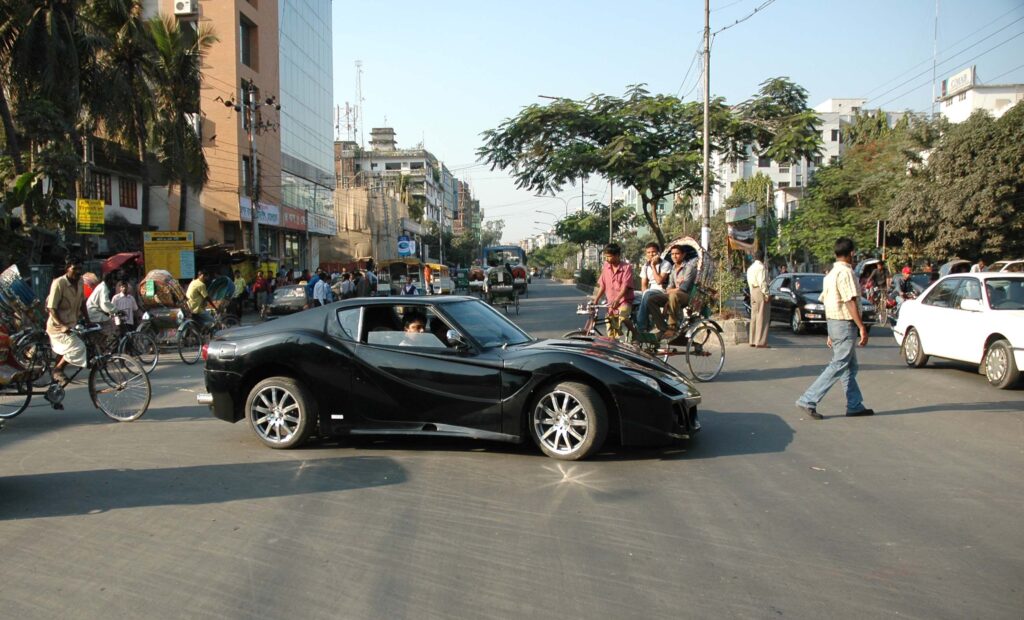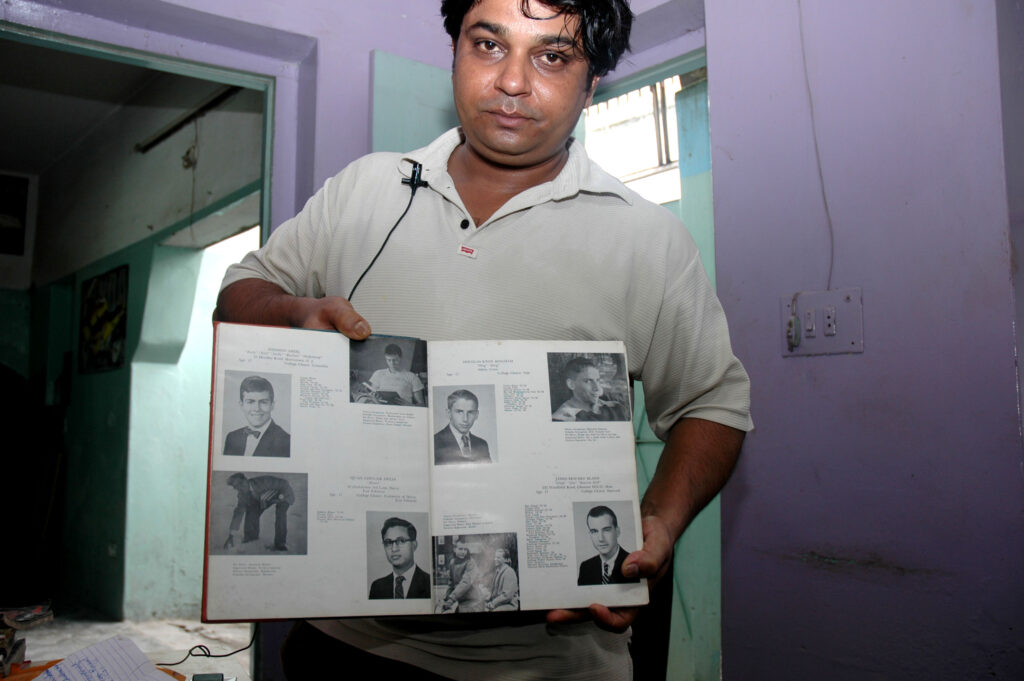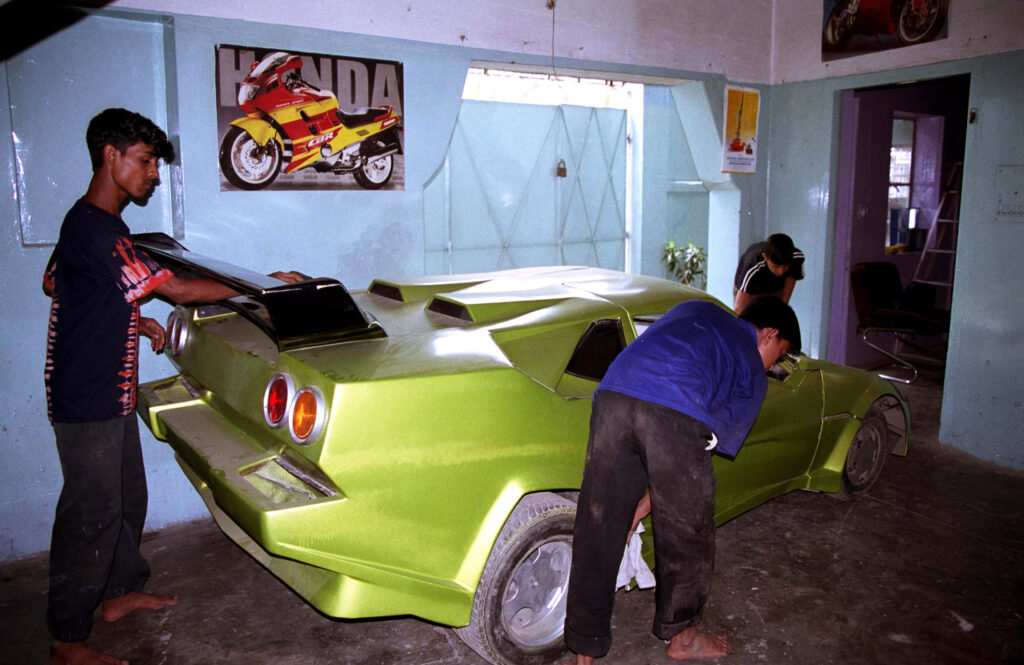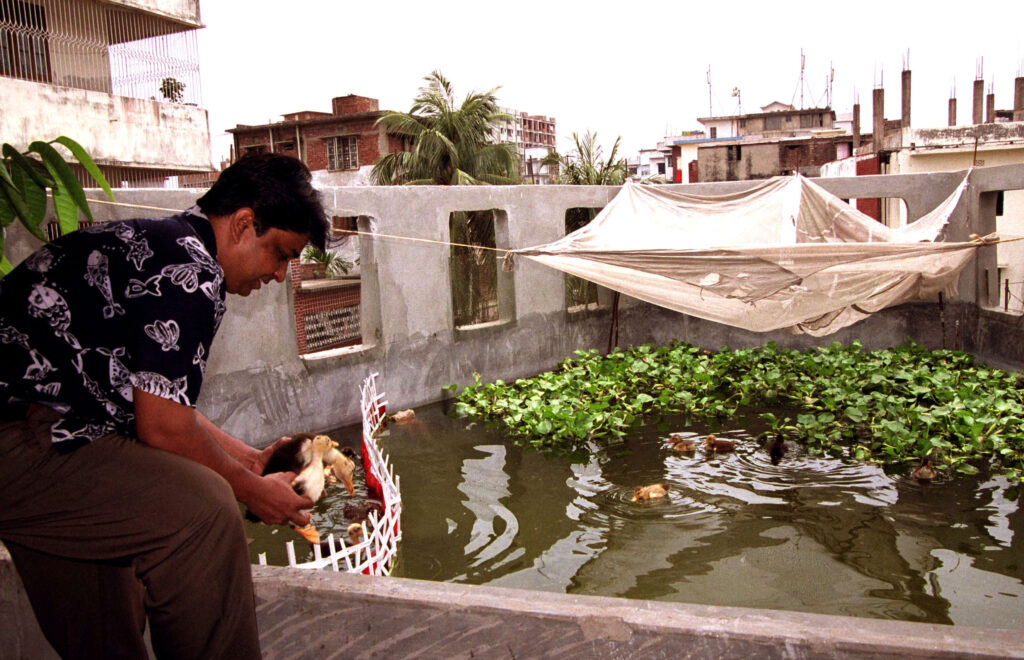Nizamuddin Awlia Leepu is a unique personality and his seemingly eccentric character and wild dreams have brought Bangladesh to the world stage of car making. Who would believe that one can drive a ‘Made in Bangladesh’ supercar F71? This was his own creation, a high-quality workmanship was inspired by Ferrari F50.


By looking at the F71, it is hard to comprehend that it was made by a young Bangladeshi man working from a small workshop at the bottom of his four-story family house in Jikatola, Dhaka. But this is absolutely true! Although at first he was only engaged in modification and made copies of well-known sports cars, such as Ferrari and Lamborghini, as well as making a Limousine, he has now embarked on making designer cars, based on his own creative ideas.
Although there are others involved in the modification of cars in Bangladesh, Nizamuddin is quite unique and operates at a very different level altogether. Others add bits and pieces to cars without changing their main identity. He, Mr Awlia, changes the looks, character and structure of cars and gives them a completely different identity. For example, a Honda Prelude was transformed into the F71, inspired by Ferrari F50. Leepu now plans to make ‘supercars’ by designing and transforming cars into amazing-looking vehicles, and believes that his particular efforts will be a catalyst and help turn ‘Bangladesh into a designer-car nation’. At least, that is his dream!


That’s now and Leepu’s dreams for the future. But how did he come to be in this position? What were the influences in his early life that generated his intense love for cars and interest in making them himself?
Born in 1967 in Dhanmondi. While tracing his family history he recalls that his grandfather served as a police officer during the British Raj and lived in the old part of Dhaka. His father, Qazi Gulam Awlia, studied at the famous Armanitola School and later obtained a Korean War Memorial Scholarship in 1957 to study in the USA at the Milton Academy.

Subsequently, he went to London for further studies but returned to Bangladesh in 1966. While returning from London his father wanted to bring back to Dhaka a car that he really liked, but, unfortunately, he could not do so at that time.
However, his father did buy a Voxwagon Beetle in 1972. While growing up Leepu observed how the car was kept immaculately clean and maintained in good condition. This led him to feel that automobiles were wonderful arts.
In 1975, he enrolled at the Residential Model High School in Dhaka, where arts, crafts and music were mandatory subjects up to class six. Making things from wood and paper was part of the study and he found working with hands and crafting very stimulating and interesting. At that time only a very few people possessed cars in Dhaka city and everyone knew which house had a car.
In 1984 when he was studying at class 9, he moved to Riyadh in Saudi Arabia with his family as his father got a job with the American Embassy in that country. There, he had the opportunity to become familiar with big cars with powerful engines. He observed how with slight modifications a car that normally priced at $60,000 could be sold at $150,000. He also observed rich Arabs driving expensive and powerful cars.
In Saudi Arabia, he attended two motor shows, first in Jeddah in 1985 and then in Riyadh during the following year. The range of cars on display had a mind-blowing experience for him and while still in that country he started to dream about making it possible for people in Bangladesh to drive similar supercars but at a more affordable price. This dream motivated Leepu to eventually produce a number of supercars, inspired by well-known brands such as Lamborghini and Ferrari.
A number of years was to pass before his dreams started to be realised. In Riyadh, he continued his studies, first taking the SSC (Matrix) exam organised by the Bangladesh Embassy. This time he passed with excellent results unlike the previous attempt in Bangladesh where he was not so successful. He then enrolled at the reputable Pakistan International College in Riyadh to study a pre-engineering course. Luck struck him at that time when he came to possess his first car, Mazda, given by his father for his college travel.
He learnt to drive and began to examine cars very carefully – the parts, engines and structures. Leepu was not able to finish his studies at the college as the whole family returned to Bangladesh before the completion of the course. In Bangladesh, he became intensely interested in learning more about cars in order to make supercars. He searched for possible courses to attend and potential people with the necessary technical expertise to help him realize his dream of building supercars.
Although his search for local expertise was disappointed, he did find a three months course on automotive and enrolled at the Bangladesh Industry Technical Centre (BITAC). But he soon realized that this course was not suitable for his requirements as his knowledge and understanding were far more advanced than what the course offered. Although he lasted barely one month, however, he took the opportunity to utilise some of the facilities at the centre to practice welding, moulding, etc. He was interested in learning how to build a car and did not want to attend a course just to obtain a certificate.
Leepu regularly visited the New Market and the book market in Neelkhet to buy books on cars. The famous Dulai Khal was another important car spares market that formed part of his regular itinerary which he visited to familiarise himself with car parts. All the libraries in Dhaka were searched for books on the automotive body but found it difficult to locate any.
However, finally, he found luck at BITAC, where he found a general motor book, published in 1940, on how to repair an automotive body.
Then he embarked on his first project which involved totally dismantling and reassembling a Honda, purchased for 65,000 taka. He wanted to test his own ability. This was a very important learning process for him and the successful outcome gave him a lot of confidence. The Lamborghini project followed taking about 1.5 years to complete and involved utilizing two Voxwagon Beatles. The finished car was named Leepu 2000. The challenges involved in the project and their successful overcoming meant that Leepu could now undertake even greater and more complex projects
Seeing his interest and love for cars and the making of Leepu 2000, his father suggested that he should go to America to study with General Motors and obtain qualifications from the best institution in the world. However, Leepu was not interested in obtaining an academic qualification. Rather, he wanted to learn as quickly as possible how to design and build cars. Instead of studying for a general Motors course, he enrolled with Hamilton High to obtain a diploma in automotive body and automotive mechanical. While at this institution he impressed teachers and fellow students with pictures of the Leepu 2000, the Lamborghini inspired car. The experience at Hamilton High was very valuable and for a while he also ran a small workshop at Los Angeles airport repairing cars. Rather than staying in the USA, he decided to come back to his homeland and pursue his dreams in Bangladesh.

His primary reason for coming back to his homeland was to help develop local capacity, produce supercars and demonstrate that if people had dreams they could realize amazing things. He was quite young and labour time was very cost-effective and thought that he still had the youth to achieve something.
Among possible projects that may emerge from Leepu’s creative talents will include, as well as many more supercars with unique and amazing designs, small vehicles which could be affordable to and utilized by ordinary people. Other possibilities are rickshaw replacements, agree-cultural equipment, e.g., small tractors.

Does he have a favourite car? Not at the moment, although in the past at different times he had different favourite cars.
Although he never actively sought publicity, features and programmes on his achievements have been continuously appearing in both local and international media outlets. Through building a number of supercars he developed and expressed his own creative talents and got worldwide publicity, including BBC 24 TV, Intersection Magazine, Bangladesh TV and papers in Bangladesh and the Middle East.
What about the city of his birth and his personal likes and dislikes? He came back to Bangladesh from America for a number of reasons. Off course, Dhaka is his birthplace and he likes many things about the city.
Old Dhaka is his favourite and Leepu particularly loves to visit the Dulai Khal car spares market. The characteristics of old Dhaka continue to interest him – the narrow roads, foods on offer and the general business life. Leepu feels that he can learn a lot from old Dhaka and is always very impressed by the devotion of the people with respect to running their business, food preparation and preserving their traditions. Old Dhaka has bustling markets and a variety of ingredients and spices on offer. The area is also the premier distribution centre in Dhaka for industrial goods, imported fish, vegetables, etc. brought in by ships and boats through the Buriganga River. It also has rich history and heritage.
One thing he dislikes about the city is the drive of many of its residents to become solvent very quickly without laying the necessary foundation. He feels that although becoming solvent is a natural and innate desire of every human being the race to become solvent quickly causes degeneration of positive social values. According to Leepu, solvency should follow a good education, acquiring technical expertise, learning to run businesses and working hard. But people in Dhaka want to become rich quickly and society suffers as a result.
On the question of Dhaka’s future, Leepu feels that this is a hypothetical and difficult question. Although he has been observing many positive developments recently his level of optimism is restricted by a number of factors. Leepu feels that the city lacks a proper vision and, as a result, the people don’t know where it is going.
With regards to the rapid changes taking place in Bangladesh, particularly in relation to westernization in terms lifestyles and attitudes, Leepu feels that today is an era of globalization and cultural exchange and influence will affect all countries. Western influences coming to Bangladesh could be a positive thing and has been in many respects, but that they should only be accepted as complementary to local life, traditions and culture.
Bangladesh should be ready and positively accept good things from wherever they originate, even if from mars or the moon. Uncritical acceptance of all things western can be harmful and should be avoided. Rather than as a replacement of Bangladeshi tradition and culture, western and other outside influences should be incorporated to help bring advancement to the country. According to Leepu, those who uncritically accept westernisation are people who have low self-esteem and lack a strong sense of identity. They feel more credible when they uncritically imitate all things western.
In terms of eating preferences, Leepu’s favourite is seafood. However, as he is very busy he does not really have the time to indulge in pursuing his favourite things. He likes to cook and cooked quite a lot when he lived in the USA. But now in Dhaka, the food is cooked by his wife. While abroad his cooking mainly consisted of Bangladeshi style with a creative Nazimuddin’s touch. One wonders whether any new superfood will emerge from his kitchen.
Leepu enjoys music a lot, especially those with a high level of creative composition, and includes both western and local. He feels that they inspire him and he enjoys their rhythms very much. He is very interested in music – both listening and singing – especially old types of music including western. Examples of music that he enjoys listening include Mozzart, Rabindra Sangeet and Indians gazzals. Leepu is also a singer and has organized and sang in events in the past. While working on his cars he sings and the rhythms help to energies and inspire him to continue working.
Culture, music and arts are considered to be very important by Mr Awlia. He feels that a good society cannot be achieved without developing its beauty in terms of arts and culture. In relation to the contribution that popular music is making to society, he does not view their role favourably.
Leepu’s eccentricities have no bounds! A strong desire to enjoy and experience the Bangladesh village life that cannot be part of life any more lead him to design the top floor of their four-story family house in Jikatola based on the village settlement structures. In this regard, he created a central courtyard-style space (village uthan) with surrounding rooms and with a traditional looking pond looking outside with fish, ducks and flora.
